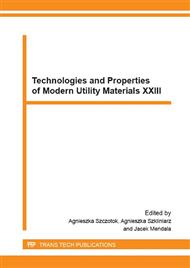[1]
R.R. Boyer, An overview on the use of titanium in the aerospace industry, Mat. Sci. Eng. A213 (1996) 103-114.
Google Scholar
[2]
R. R Cervay, SCS-6/b21S Mechanical Property Evaluation, NASP Contractor Report 1165 (1994).
Google Scholar
[3]
Information on http: /www. timet. com.
Google Scholar
[4]
Z.Q. Chen, Y.G. Li, M.H. Loretto, X. Wu, Role of alloying elements in microstructures of beta titanium alloys with carbon additions, Mater. Sci. Tech. 10 (2003) 1391-1398.
DOI: 10.1179/026708303225005999
Google Scholar
[5]
Y.G. Li, M.H. Loretto, D. Rugg, W. Voice, Effect of heat treatment and exposure on microstructure and mechanical properties of Ti-25V-15Cr-2Al-0. 2C (wt. %), Acta Mater. 49 (2001) 3011-3017.
DOI: 10.1016/s1359-6454(01)00206-3
Google Scholar
[6]
M. Chu, I.P. Jones, X. Wu, Effect of carbon on the microstructure and mechanical properties of a eutectoid b titanium alloy, J. Mater. Eng. Perform. 14(6) (2005) 735-740.
DOI: 10.1361/105994905x75538
Google Scholar
[7]
A. Szkliniarz, Effect of heat treatment on the microstructure and properties of Ti-8Al-1Mo-1V alloy with carbon addition, Solid State Phenom. 229 (2015) 131-136.
DOI: 10.4028/www.scientific.net/ssp.229.131
Google Scholar
[8]
A. Szkliniarz, W. Szkliniarz, Effect of solution treatment on the microstructure of Ti-C alloys, Solid State Phenom. 212 (2014) 7-10.
DOI: 10.4028/www.scientific.net/ssp.212.21
Google Scholar
[9]
Y.G. Li, P.A. Blenkinsop, M.H. Loretto, D. Rugg, W. Voice, Effect of carbon and oxygen on microstructure and mechanical properties of Ti-25V-15Cr-2Al (wt%) alloys. Acta Mater. 10 (1999) 2889-2905.
DOI: 10.1016/s1359-6454(99)00173-1
Google Scholar
[10]
Z.Q. Chen, Y.G. Li, D. Hu, M.H. Loretto, X. Wu, Effect of carbon additions on the microstructure and mechanical properties of Ti-15-3, Jo. of Mat. Sci. & Tech. 20 (2004) 343-349.
Google Scholar
[11]
J. Grauman, S. Fox, S. Nyakana, Titanium alloy having improved corrosion resistance and strength, United States Patent US2006/035867, (2006).
Google Scholar
[12]
M. Niinomi, J. C Williams, Properties and Applications of Ti: Current Status and Future Needs, Ti-2003 Science and Technology, WILEY-VCH Verlag GmbH & Co. KGaA, Weinheim 2004, vol. 1, 95-110.
Google Scholar
[13]
M. Niinomi, Recent trends in titanium research and development in Japan, Proceedings of the 12th Word Conference on Titanium, Science Press Beijing, 2012, pp.30-37.
Google Scholar
[14]
G. Welsch, F. Rodney, E. Boyer, W. Collins, Materials Properties Handbook: Titanium Alloys, ASM International, USA, (1994).
Google Scholar
[15]
A. Szkliniarz, Possibility of deformation of Ti-6Al-4V alloy with carbon, Solid State Phenom. 176 (2011) 149-156.
DOI: 10.4028/www.scientific.net/ssp.176.149
Google Scholar
[16]
A. Szkliniarz, R. Michalik, Characteristics of Corrosion Resistance of Ti-C Alloys, Solid State Phenom. 191 (2012) 235-242.
DOI: 10.4028/www.scientific.net/ssp.191.235
Google Scholar
[17]
A. Szkliniarz, Effect of carbon addition on the microstructure and properties of unalloyed titanium, Solid State Phenom. 212 (2014) 3-6.
DOI: 10.4028/www.scientific.net/ssp.212.3
Google Scholar
[18]
S.A. Mantri, D. Choudhuri, A. Behera, J.D. Cotton, N. Kumar, R. Banerjee, Influence of fine scale alpha precipitation on the mechanical properties of the beta titanium alloy Beta-21S, Metall. Mater. Trans. A, accepted in (2015).
DOI: 10.1007/s11661-015-2944-y
Google Scholar
[19]
W. Szkliniarz, J. Chrapoński, A. Kościelna, B. Serek, Substructure of titanium alloys after cyclic heat treatment, Mater. Chem. Phys. 81 (2003) 538-541.
DOI: 10.1016/s0254-0584(03)00069-5
Google Scholar
[20]
Information on http: /asm. matweb. com.
Google Scholar
[21]
Information on http: /www. titaniuminfogroup. com.
Google Scholar


